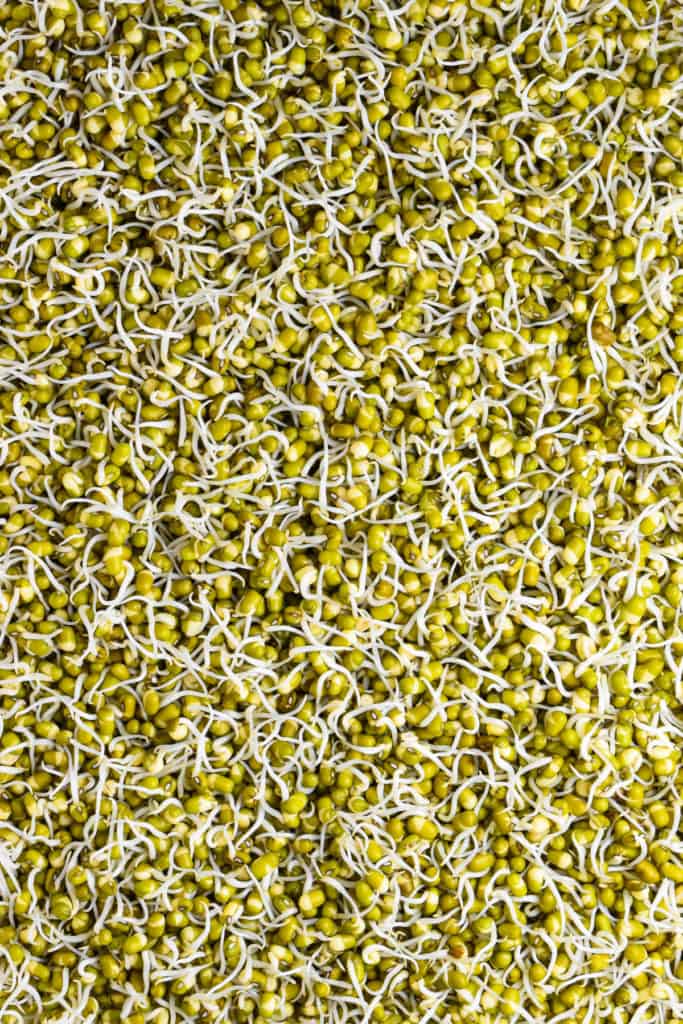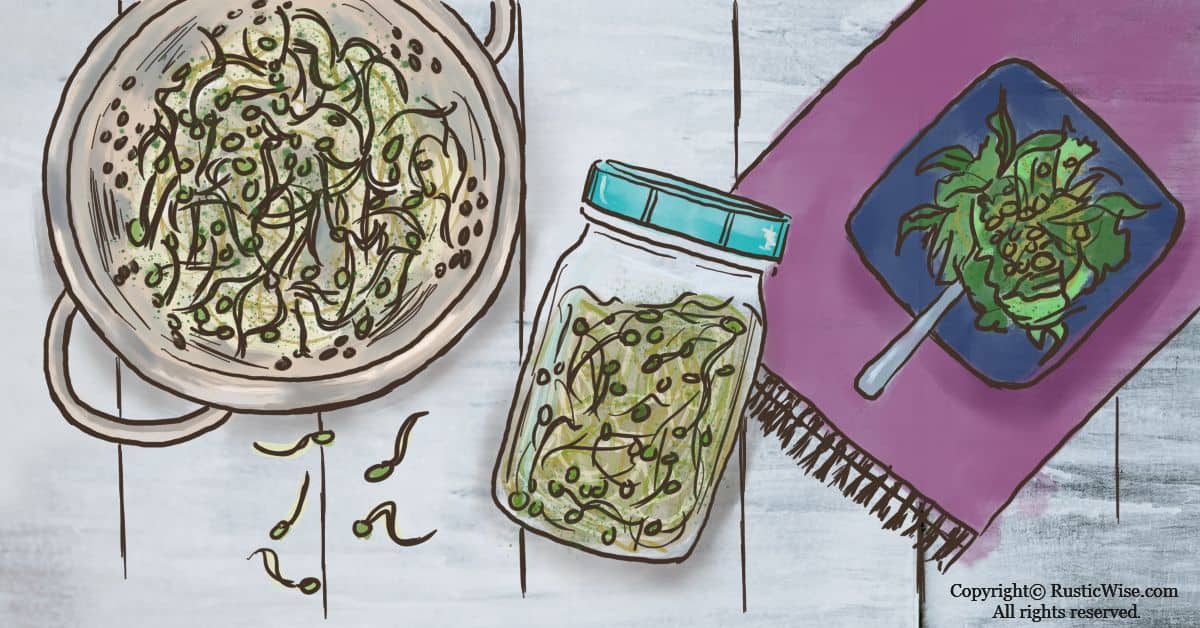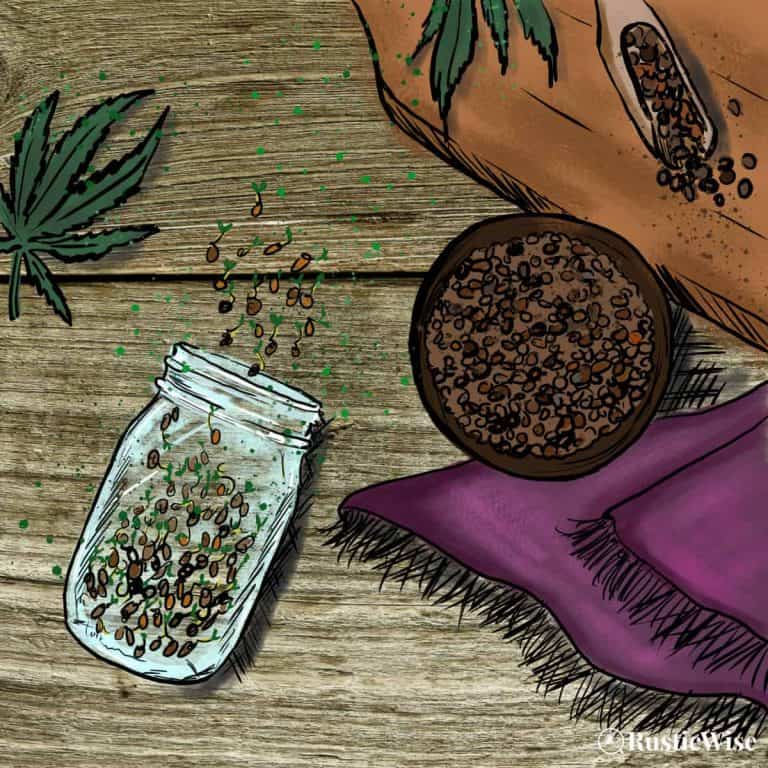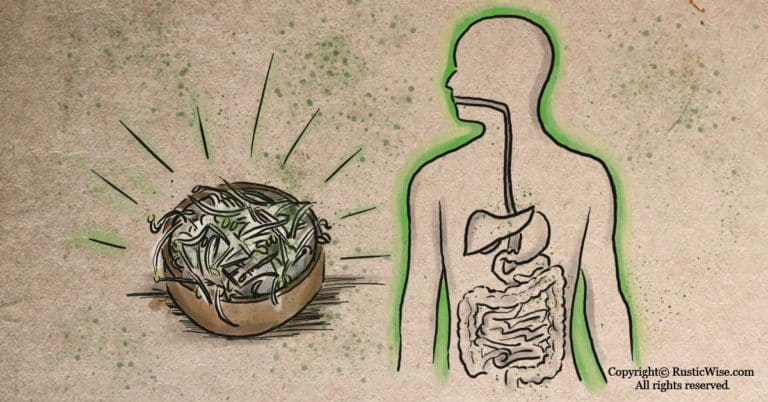When To Harvest Sprouts + Sprout Maturity Chart
So you’ve soaked your seeds and have been a good plant parent by diligently rinsing your sprouts. Now the seeds have sprouted. So how do you know when to harvest sprouts? All sprouting seeds have varying harvest times. However, it’s a tell-tale sign your sprouts are ready to harvest when you see the hulls or seed casings begin to fall away during rinsing.
Seed sprouts are a wonderful way of growing greens all year-round indoors. You don’t need anything too fancy (heck, you can even make your own sprouting container out of a mason jar). You don’t need much space or sunlight. Plus, sprouts are packed with vitamins and nutrients.
And just to make sure we’re on the same page, we’re referring to sprouts, not microgreens. While these terms are often used interchangeably, sprouts and microgreens are different.
You eat sprouts in their entirety—seed, root, and shoot. They’re grown without soil. Microgreens on the other hand are essentially “baby” plants that are harvested right above the soil line. Same, same, but different.
Signs your sprouts are ready to harvest
How do you know when to harvest sprouts? While different sprouting seeds have different maturity times, keep the following in mind:
- Appearance: Look for the outer seed coverings or hulls loosening after each rinse. When a lot of the hulls have separated from the seed, it’s a good sign your sprouts are ready for harvesting.
- Time: Some sprouts have quick maturity times and might be ready for harvesting in as little as two days. This is often the case for seeds like buckwheat and adzuki beans for example.
- Growth: Look for healthy growth. If you’re growing mung beans, they may grow up to 2 inches (2.5 centimeters) long. Other bean seed sprouts may grow 1-2 inches (2.5-5 centimeters).
- Taste: When growing sprouts at home, trust your own instincts and taste buds. Feel free to taste the sprouts after each rinse to harvest according to your own taste preferences. Many sprouts when harvested earlier have a milder, fresher taste, while those harvested later usually develop a stronger flavor.
The takeaway: There isn’t really a wrong or right time to harvest. The best way to know when to harvest is to tap into your inner-gardener instinct. And of course, your taste buds won’t lead you astray.

Credit: Abhishek Hajare / Unsplash
When to harvest sprouts: sprouts maturity chart
As we mentioned already, every sprouting seed has different “best” harvesting guidelines. Even the same type of seed from different seed producers may have different recommended guidelines.
So, this makes it very confusing for everyone, especially for newbie sprouters.
We’ve scoured the internet and checked a variety of sources including Johnny’s Seeds and Sprout People.
And even though we said to trust your instincts, sometimes, it’s nice to have a guideline, you know?
The following is intended to be a general guideline. It’s best to follow the instructions on your individual seed package for the most accurate sprout maturity times.
| Sprout Name | Time to Harvest (days from dry seed to harvest) | Flavor |
|---|---|---|
| Adzuki | 2-4 | Mild, slightly sweet and nutty. |
| Alfalfa | 4-6 | Mild, slightly crunchy—great in sandwiches. |
| Amaranth | 2-4 | A tiny sprout, used as a carbohydrate-alternative, great in breakfast cereals. |
| Barley sprouts (white or purple) | 2-3 | Chewy, low in gluten, used in cereals and baking. |
| Broccoli | 3-7 | Tastes like mild, tangy broccoli, mild crunch. |
| Buckwheat Groat | 1-3 | Slightly nutty and tender, great as a breakfast cereal. |
| Cabbage (green and red) | 3-6 | Crunchy and sweet—great in sandwiches. |
| Clover | 5-6 | Similar to alfalfa, mild, tangy, and crunchy. |
| Cress | 3-4 | Slightly spicy and tangy, similar to mustard. |
| Fenugreek | 4-8 | Fragrant and slightly bitter. |
| Garbanzo beans | 2-4 | Mild, slightly sweet, and nutty. |
| Green pea | 2-3 | Slightly bittersweet and refreshing. |
| Kale (green) | 3-7 | Mild and slightly nutty. |
| Lentil | 2-5 | Slightly sweet and peppery. Great fresh, or hardy enough to add to soup. |
| Mung (moong) bean | 2-6 | Fresh, crunchy and sweet. |
| Mustard | 4-8 | Spicy! Add some kick to your salads and sandwiches. |
| Quinoa | 1-3 | Mild and crunchy, slight flavor of beets. |
| Radish | 2-5 | Tastes like a bite-sized version of its fully-grown self—spicy and flavorful. |
| Rye | 2-3 | Slightly nutty and chewy. |
| Sunflower | 2-10 (Varies widely, depends on the type of sunflower seed) | A mild, sweet, and nutty sprout, great for adding to breads and breakfast cereals. |
| Wheat | 2-5 | Sweet and chewy; use as you would a grain (breads, baking), or in salads. |
How to harvest sprouts
To harvest sprouts, no scissors required! All you need is:
- Water
- A colander
- Basin
- A large bowl to drain the colander in
When you’ve determined that your sprouts are ready to harvest, it’s time to give it a final rinse and “look over.” The final rinse helps remove any loosened hulls or other unsprouted seeds that you don’t want to eat.
Fill a clean basin with cool water. Take a handful or two of your sprouts and gently swirl the sprouts in water. This helps to separate the hulls as they float to the surface. While hulls are edible, not everyone enjoys their chewiness.
Place your cleaned sprouts into a colander and allow to drain. Place a clean bowl to catch the draining water. Periodically tilt the colander at different angles until sprouts have completely drained.
Note: If you’ve used a jar to grow your sprouts, you may notice that the sprouts in the middle of the bunch look paler, or less green than the others. This is because they haven’t had much access to sunlight. If this is the case, place the clean sprouts in indirect sunlight for a few hours to allow the sun to activate the chlorophyll and “green” your sprouts. Avoid putting your sprouts in direct sunlight as this may dry out your sprouts.
That’s it! Your sprouts are ready to eat.
For more information, check out our post, How to Rinse Sprout Seeds.
How to store your sprouts
It goes without saying that too much water leads to mushy, gross sprouts. It’s important to allow your sprouts to thoroughly drain before refrigerating.
Store your clean, dry sprouts in a perforated plastic bag, or a container with air holes. Most homegrown edible sprouts keep up to 1 week, but are best used within 3-4 days.
Sprouts recipe roundup
Check out these tasty and healthy recipes for sprouts!
Mung Bean Sprouts Recipe
Rich in vitamins C and K, mung bean sprouts are perfect for sautéing. Check out this Asian-inspired recipe with garlic and scallions (via I Heart Umami).
Brown Rice Salad with Crunchy Sprouts and Seeds
If this recipe sounds healthy, it’s because it is. Make your own hearty rice salad with sprouts (mung or lentil) – via Bon Appétit.
Crispy Omelette Baskets Recipe
Start your day with an omelette filled with veggies, bean sprouts and baked in potato baskets (via NDTV Food).
Simple Recipes Using Homegrown Sprouts
One page, three recipes. Grab a recipe for Vietnamese Sprouted Spring Rolls, Sprouted Lentil Burgers, and Korean Soybean Sprout–Miso Soup (via Chelsea Green Publishing).
3 Sprouted Lentils Recipes
If you’ve sprouted lentils at home, check out this page for 3 recipes: Sprouted Lentil Slaw, Spicy Sprouted Lentils, and Sprouted Lentil Tacos (via Traditional Cooking School).

Author: Josh Tesolin
Josh is co-founder of RusticWise. When he’s not tinkering in the garden, or fixing something around the house, you can find him working on a vast array of random side projects.










